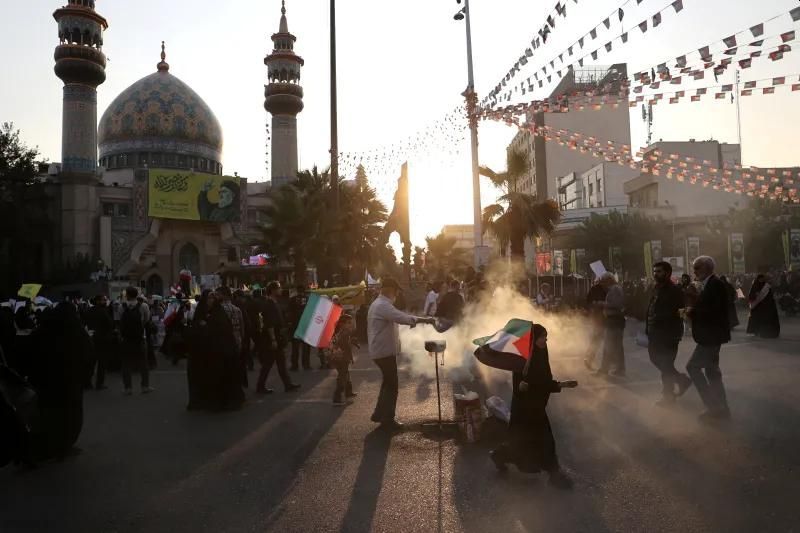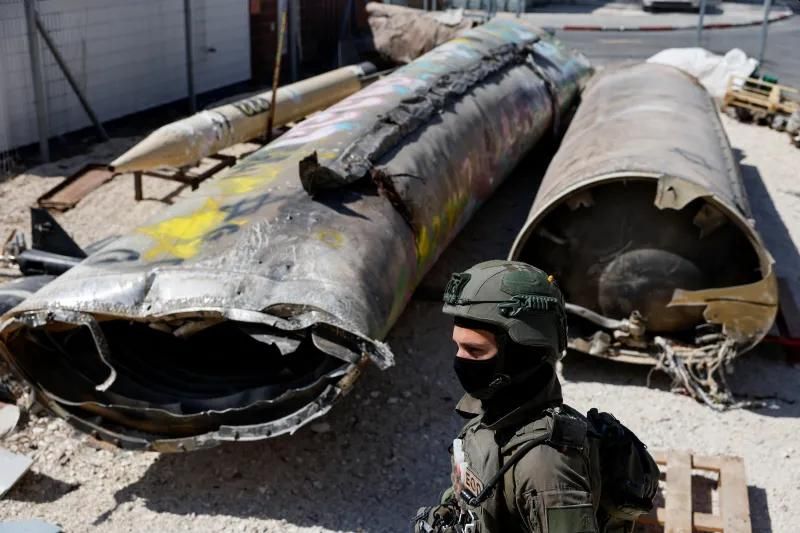By Eric Vandenbroeck and co-workers
Iran And Israel Face Limitations That
Make Massive Escalation Unlikely
Many analysts
watching the conflict in the Middle East have
warned that the present fighting could escalate further. At the moment, such
fears are concentrated on the prospect of a war between Iran and Israel.
Of course, that war
is already underway. Iran has launched two direct attacks on Israel, while
Israel has carried out one strike in response and is almost certainly preparing
a second. A half dozen Iranian allies and proxies have attacked
Israel, including in terrorist assaults; Israel has assassinated a passel of
key Iranian leaders; and both sides have carried out cyber strikes.
So the real question
is not what a war between Iran and Israel would look like but what an expanded
conflict between them might entail. The answer, in essence, is this: more of
what is happening right now, just with increased intensity. That is because both
sides face significant material and strategic obstacles that make an imagined
all-out war between them unlikely.
Iran trails Israel in
almost all offensive and defensive capabilities, so it simply cannot inflict
devastating damage. Israel, meanwhile, has a tremendous capacity for targeted
strikes, but it does not have the variety of resources that a war of conquest
or devastation against Iran would require. Both states are physically too far
apart and lack the capacity to launch invasions by ground or sea. These
obstacles mean that unconstrained warfare is doubtful, and even to the extent
that there is an escalating exchange of blows, Armageddon is unlikely.
The Tyranny Of Distance
The most important
factor constraining a war between Iran and Israel is distance. The two
countries do not share a border. At their closest points, they are 750 miles
apart. Central Israel is almost 1,000 miles away from Tehran.
Moreover, between
them lie Turkey, Syria, Iraq, Jordan, Saudi Arabia, and Kuwait. Some of those
countries are more aligned with Israel, some are more aligned with Iran, and
some are hostile to both. The two potential antagonists can count on help from
some—in terms of allowing their forces to pass and impeding those of the
enemy—but cannot assume much more.

Jordan’s King Abdullah II, for instance, is a
key, if tacit, ally of Israel but he rules over a majority Palestinian
population that mostly hates the Jewish state, limiting how much he can support
Israel. His country helped Israel shoot down the Iranian drones and cruise
missiles that crossed its territory during Iran’s first missile attack on
Israel on April 13. But Amman was careful to insist that it was merely
defending its air space and would do so against all foreign intruders.
Likewise, Syria is heavily dependent on Iran. But Syrian President Bashar
al-Assad was taught by his father never to fight Israel, a lesson the Assads
learned after repeated defeats in 1967, 1973, and 1982. As a result, although
Iran can move forces through and base them in Syria, Damascus has so far prevented
Tehran from mounting major attacks directly against Israel from Syrian
territory for fear that Israel would expand its attacks there.
These realities make
any kind of land invasion impossible in either direction. To invade Iran,
Israeli ground forces would have to drive through Iraq and Jordan or Iraq and
Syria, which would be logistically challenging and strategically foolish. Iran
is 80 times as large as Israel, and even if Israel could find a way to get half
of its dozen or so ground divisions there, they would be swallowed up by the
Islamic Republic’s vast geographical expanse and would have little ability to
accomplish anything meaningful, nor would Israel ever want to send so much of
its citizen army so far away.
The Israelis have
been able to destroy key enemy facilities with small special forces teams
inserted by air, and they very well might stage one or more such operations
against important Iranian targets. But the Israeli military could not occupy
Iranian territory in this way without a route to resupply and reinforce a first
wave of air-dropped units.
The Israeli Defense
Forces, of course, also boasts a capable navy, and Iran has a lengthy
coastline. The IDF might mount a battalion-sized or even brigade-sized raid
against an important Iranian coastal facility using one or more jury-rigged
naval transports of some kind. But Israel lacks the amphibious assault and
carrier-based air capabilities needed to mount a larger invasion from the sea.
Unless Israel could base fighter squadrons in Bahrain or the United Arab
Emirates, which is highly unlikely, maintaining a force ashore for more than a
few hours in the face of Iranian missiles and airstrikes would be exceptionally
difficult. Even if these forces could somehow seize and hold a beachhead,
sustaining it would require getting Israeli transport vessels through both the
Houthi-menaced Bab el Mandeb Strait and the
Iranian-threatened Strait of Hormuz. Consequently, such a small raiding force
could realistically destroy only one or a few high-value Iranian facilities
near the sea before it had to withdraw out of range of Iranian air and sea
forces.
Iran’s navy would
face even more formidable obstacles trying to mount an amphibious invasion of
Israel against the air, sea, and ground forces of the Jewish state, not to
mention the logistical nightmare of trying to move and supply forces there by
circumnavigating all of Africa. A ground offensive against Israel would be only
slightly more appealing. In theory, Iran has the logistical advantage of free
passage through Iraq and Syria. But its ground forces are the weakest and most
backward element of its armed forces, and they would not stand a chance against
an IDF mobilized to defend its heavily fortified positions on the Golan
Heights. Iran knows this: that is why the government has not deployed large
Iranian ground forces to the Damascus area. Instead, Iran has reportedly massed
as many as 40,000 Afghan, Iraqi, Pakistani, and Syrian militiamen in southwest
Syria who could be used to launch a massive assault without jeopardizing the
lives of Iranian citizens or, Tehran hopes, triggering an Israeli response
against Iran.
Yet that kind of
attack would almost certainly result in a catastrophic defeat, with vast
numbers of these lightly armed and poorly trained forces slaughtered by Israeli
ground and air forces. That Tehran has not already attempted such an assault
suggests they realize its futility. Israel’s invasion of Lebanon has greatly
degraded Hezbollah—Iran’s ultimate deterrent against an Israeli attack on Iran.
If Tehran thought these militias could save its close partner, it almost
certainly would already have thrown them at the Israelis.
Iranians protesting Israel
in Tehran, October 2024

Thin Air
These limits on
ground operations mean that the conventional aspects of a wider war between
Israel and Iran would fall mostly to their air forces, which are also limited
in what they can do. Israel possesses ballistic missiles that could range all
of Iran and have cruise missiles and drones that can do so from ships and
submarines, and probably from Israel itself. No one knows how many of these
Israel has, but it is not a huge number—probably in the high hundreds or low
thousands for each. All have relatively small warheads, nothing like the
payload that manned aircraft can deliver. That makes them very useful for
destroying relatively small, high-value Iranian targets—military equipment and
buildings, but not vast bases, let alone cities.
Although Iranian air
defenses would complicate the operations of Israel’s manned aircraft, they
would act as little more than an annoyance. The real problem for Israel would
be the distance. Israel’s F-15s can certainly make those flights, but its
cutting-edge F-35s and F-16s, which represent the bulk of its combat air force,
have ranges of only about 600 miles. Israel’s long-range, standoff munitions
can boost that figure by several hundred more, but it would still be a
significant undertaking for those aircraft to hit targets in central Iran
without aerial refueling.
Israel has a small
number of long-range refueling aircraft, and although its air force has skilled
pilots who routinely fly them in ways that no other country would dare, the
planes are big and very vulnerable. It would be difficult and dangerous for Israel
to employ them routinely in hostile airspace. Although none of Israel’s
American-made fighter aircraft were designed to refuel one another in flight (a
technique known as “buddy refueling”), the Israelis may have modified them to
do so. That, however, would introduce other inefficiencies; half of Israel’s
fighters would do nothing but refuel the other half. So
unless Jordan or Saudi Arabia opens its airspace to the Israeli air force
(as they did on April 13 to combat the Iranian missile and drone attack on
Israel), the Israelis would have to pick and choose when to employ manned
aircraft to strike Iran.
Iran has two air forces,
one belonging to the regular armed forces and the other to the Islamic
Revolutionary Guard Corps. But neither can hold a candle to the Israeli air
force. Iran has no dedicated refueling aircraft and only a few dozen old
French-made fighters that could buddy refuel. Its aircraft are overwhelmingly
American models dating from the 1960s and 1970s and French and Soviet planes
from the 1970s and 1980s. However many of them could even make the flight to
Israel would not stand a chance against Israeli air defenses.
That would put the
onus of an Iranian air campaign back on its missile and drone force. Like
Israel, the Islamic Republic probably has hundreds (or even a number in the low
thousands) of these left with the range to hit Israel. In its strikes on April
13 and October 1, however, Iran launched a combined total of 500 of them and
did virtually no damage. There are reports that Russian technicians are trying
to help the Iranians improve both the survivability and the lethality of these
missiles, but the six months between those two Iranian attacks did not show any
significant improvement. It is humiliating for Iran to keep striking and
failing in this way. Worse, it invites far more painful Israeli retaliation.
What all of this
should make clear is that Israel can inflict a considerable amount of pain on
Iran through relatively small, highly precise air, drone, and missile strikes,
whereas Iran will have trouble causing Israel much pain at all. And neither
country is in a position to mount a massive, sustained air campaign against the
other. That is why even an expanded war between them won’t look anything like
the German Luftwaffe’s Blitz or the British-American Combined Bomber Offensive
against Germany in World War II—or even anything that would look like more
recent U.S. air campaigns against Serbia and Iraq, or the kind of air campaign
Israel is now waging against Hezbollah.
Unconventional Warfare
Both sides would
likely try to complement (or substitute for) their conventional military
operations with further cyber strikes and covert actions. As to the latter,
Israel’s advantage appears to be even greater than it would be in an air war.
For decades, the Mossad, Israel’s intelligence agency, has demonstrated an
extraordinary ability to assassinate VIPs and sabotage critical facilities
inside Iran. It is unclear how long it took Israel to set up such operations,
how easily it can improvise new ones, or whether it has others already
prepared.
By contrast, Iran has
come off as impotent in this arena as well. Although it has reportedly tried to
kill senior Israeli officials, it has so far failed. Its best effort seems to
have been a small terrorist attack on the night of October 1, which was carried
out at the same time as its second missile and drone attack and which killed a
half dozen people in Tel Aviv. Iranian personnel may have been involved in a
number of small-scale terrorist attacks in Israel during the past year, but
they all pale in comparison with Israel’s astonishing covert successes.
In the cyber realm,
Iran appears to be in a somewhat stronger position but still seems outmatched
by the Israelis. Iran has spent almost two decades developing its cyberwar
capabilities, and they’ve gotten good enough to wreak havoc on undefended
targets. The Iranians have even shown some ability to hit harder targets. But
in cyber exchanges, the Israelis have consistently prevailed. For instance,
during the summer of 2023, Iranian cyberattacks shut off the power at several
Israeli hospitals and health clinics. But the Israelis responded by launching
cyber-assaults of their own, shutting down gas stations across Iran. Tehran
stopped its attacks.
Of course, the whole
point of cyber-operations is that neither side knows what the other can
do—because if they knew, they would eliminate their vulnerabilities. It is
possible that Iran is holding some truly devastating cyberweapons in reserve.
It is equally possible that Israel is, too—and so far, the evidence suggests
that the Israelis are both more likely to hurt Iran and better prepared to
limit the damage from Iranian attacks.
The Strategic Environment
Both Iran and Israel
face strategic conditions that further limit the potential scope of a conflict
between them. Not only does Iran understand that it is fighting at a pronounced
disadvantage against Israel in conventional and even unconventional warfare but
the Iranians believe that Israel possesses an array of weapons of mass
destruction. Although the Iranian regime is often accused of irrational
behavior, the reality is that it has shown considerable prudence and would
undoubtedly seek to avoid taking any action that could provoke a massive
Israeli response.
The remains of Iranian missiles on display at a
military base in southern Israel, October 2024

Similar questions
would probably also affect Israeli calculations. The IDF has the capacity to
destroy various facilities critical to Iran’s nuclear program. But it has never
done so for a crucial but typically overlooked reason: Israel and the United States
fear that a large-scale Israeli strike on Iranian nuclear sites would prompt
Tehran to withdraw from the Nuclear Nonproliferation Treaty and declare that it
had to build a nuclear arsenal as the only way to deter another Israeli attack.
Tehran would then begin constructing more facilities deep underground to
achieve that goal—like the facilities it already has at the Fordow plant near
the city of Qom, which is immune to any of the aerial munitions Israel is known
to possess. Thus, attacking the Iranian nuclear program might set it back for a
few years, only to guarantee that Iran acquires a nuclear arsenal very soon
thereafter. That would be a severe net negative for Israel.
Similarly, neither
side is likely to want to interfere with Iranian oil exports. Iran’s regime
remains almost completely dependent on oil revenues and would try to steer
clear of any actions that might affect them. Israel knows that attacking
Iranian oil exports could raise global oil prices, potentially infuriating the
United States and many other countries. Given how much Israel still depends on
American support, it seems unlikely that the Jewish state would touch that
third rail, although it might opt to hit Iranian refineries, oil storage, and
other facilities associated with Iranian domestic consumption.
What Might Make It Worse?
For all these reasons,
an expanded war between Israel and Iran is likely to consist of a sporadic
series of assaults carried out by aircraft, missiles, drones, and cyberweapons,
plus some covert operations and terrorist attacks. In other words,
more—possibly much more—of the same. Iran would probably continue to limit its
missile and drone attacks to Israeli military facilities for fear that hitting
Israeli cities could push Israel to escalate to the kind of attacks that Iran
could not match. And even if the Iranian regime decided simply to hurt Israel
as much as it could regardless of the consequences for itself, the Islamic
Republic is just not strong enough to do much damage. It could launch its
entire inventory of several thousand missiles at Israeli cities and perhaps
kill several hundred Israelis. And in that case, if the IDF decided to
retaliate against Iranian cities with hundreds of missiles and airstrikes, it
could probably kill thousands of Iranians—but that’s it. The Iranians would
then be a spent force, and although the Israeli air force could sustain small
airstrikes against Iran for weeks, unless Israel did something like
deliberately bomb an Iranian mass participant event—say, a soccer match—it is
unlikely there would be a huge increase in Iranian casualties. Neither country
would be devastated by this kind of exchange; indeed, it is exceptionally
difficult to imagine scenarios that would even bring them close to it.
It is far more likely
that Israeli strikes would focus on Iranian military targets but could include
civilian infrastructure—power plants, refineries, government buildings—and
elements of the Iranian leadership, such as Islamic Revolutionary Guard Corps and
military commanders. Even then, the Israelis would be unlikely to target Iran’s
most senior leaders, such as President Masoud Pezeshkian or Supreme Leader Ali
Khamenei. Israeli officials recognize that either man could be replaced by a
more aggressive, less prudent figure willing to incur a tremendous price in
order to inflict harm on Israel or, worse still, willing to commit Iran to
building nuclear weapons regardless of the costs.
It’s possible to
conjure black swan events—such as an Iranian-backed terrorist attack on Israel
that kills hundreds or thousands of Israeli citizens—that could cause one side
or the other to try to do more damage to the other in return. But the far more likely
prospect is that even a wider conflict would remain constrained by the
limitations of distance, diplomacy, and strategy that have shaped the war that
is already underway.
For updates click hompage here